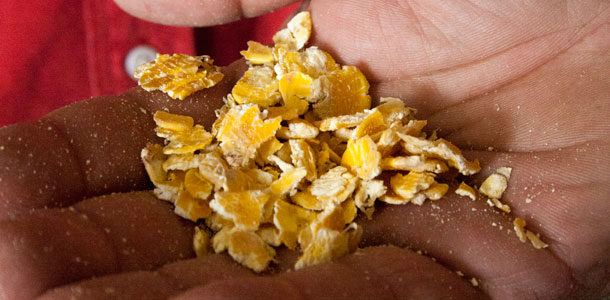There has been a lot written and discussed about increasing the digestibility of starch in dairy diets, and for good reason. Starch comprises, on the average, 25 percent or more of most dairy rations. Increasing the amount of starch digested in the rumen and available to produce microbial protein can bring big dividends to the bottom line.
By increasing microbial protein flow to the small intestine, the amino acid balance is improved and either additional milk flow or milk protein can be seen. Microbial protein is the cheapest and best-balanced source of amino acids available.
Because the amount of corn being grown for livestock feed is such a small percentage of the total crop, and corn grown for ethanol production has increased dramatically, the genetics of the plant have changed. This change to enhance ethanol production has resulted in corn grain that is lower in digestibility. Therefore, everything we can do to enhance digestibility has that much greater impact.
When I speak about increasing digestibility, I am referring to digestibility in the rumen. Even our less digestible corn is digested more than 95 percent by the time it passes through the digestive tract. Cows can still get energy from corn in the intestine, but our goal is to produce as much microbial protein in the rumen, and for this we need digestible starch.
Too much starch digesting or fermenting in the intestine can cause health problems. Bubbles and corn in the manure generally signal excess corn being fermented in the intestine. This can lead to many health issues, with hemorrhagic bowel syndrome being the predominant problem.
There are three main ways to ensure we increase starch digestion in the rumen. We must pick the right genetics and make sure the corn in both the grain and the silage is processed correctly. We also can use additives that help with starch digestion, such as enzymes.
As mentioned before, genetics can play a big role in starch digestion. Unfortunately, especially for corn grain, most dairies don’t have an option as to the varieties grown. For those that do, there are still companies producing some older genetics that would be worth checking into.
Silage is a different matter. Searching for varieties with starch digestibility numbers is a very worthwhile project. All feed labs now have the ability to test for digestible starch. Using these numbers to rank your current varieties and pick the best ones for next year can help.
The processing side of the equation is where we can have the most immediate impact. I think most dairies realize the importance of kernel processing in silage. But I find far less that scrutinize their corn grain as much.
The rumen digestibility of corn varies with how it is processed. High-moisture corn, either shelled or earlage, is the most digestible. Flaked corn would be ranked next in digestibility, followed by fine-ground corn, steam-rolled corn, medium-ground corn and then dry-rolled or cracked corn.
Each process can then be further divided by particle size. The finer the particle, the more rapid the digestion. This is mainly a function of surface area. This does not apply to steam-flaked or steam-rolled corn.
Currently, most dairies use either steam-flaked or ground corn. Let’s start with flaked corn: The digestibility of the flake is directly correlated to the flake weight. The lighter the weight, the more digestible the flake.
Unfortunately, a lot of mills don’t make the kind of flakes we need because of time constraints. In order to increase throughput, the flakes don’t stay in the steam cabinet long enough and therefore can’t be flattened enough to make high-quality flakes.
It is very easy to test flake weight on the farm. Using a very inexpensive bushel weight tester (Nasco carries them), you can determine flake weights in about a minute. Anything at or under 28 pounds per bushel is a good flake. Above that, they become steam-rolled, not flaked. The higher the number, the lower the digestibility.
Ground corn digestibility is determined by particle or micron size. The smaller the particle, the more surface area there is for the rumen bacteria to attack and digest. Going from 600 microns to 400 microns will yield about 2 pounds of milk. The lower the micron size, the longer it takes to process, so mills again are constrained by time.
But we have had good luck either working with the mills to lower particle size or finding a new mill to work with. There is a quick and easy way to quickly evaluate ground particle size. Use the Penn State box with the window screen. Shake your corn sample vigorously and measure what stays on top of the screen. If it is less than 25 percent of the original sample, your corn is ground fine.
Enzymes have a bright future in dairy feeds to increase both starch and fiber digestion. Unfortunately, right now it has been hit-or-miss as to which enzymes work and when.
There is a lot of work being done by a few companies to try to identify which enzymes work best in each situation. Shotgun feeding of enzyme cocktails is a very hit-or-miss proposition, but enzymes show extreme promise for taking dairy nutrition to the next level.
The bottom line is that starch digestibility has a huge impact on cow performance and efficiency, and therefore profitability. There are steps that can be taken to maximize starch digestibility in your herd, which will maximize health, breeding and profit. PD
Kevin Jones is a dairy nutritionist and owner of Ghost Hollow Consulting with his wife, Tammy. The company provides nutritional consulting, feed testing, whole-farm record analysis and employee training. He can be reached by email.
PHOTO: The rumen digestibility of corn varies with how it is processed. High-moisture corn, either shelled or earlage, is the most digestible. Flaked corn would be ranked next in digestibility, followed by fine-ground corn, steam-rolled corn, medium-ground corn and then dry-rolled or cracked corn. Photo by Ray Merritt.






